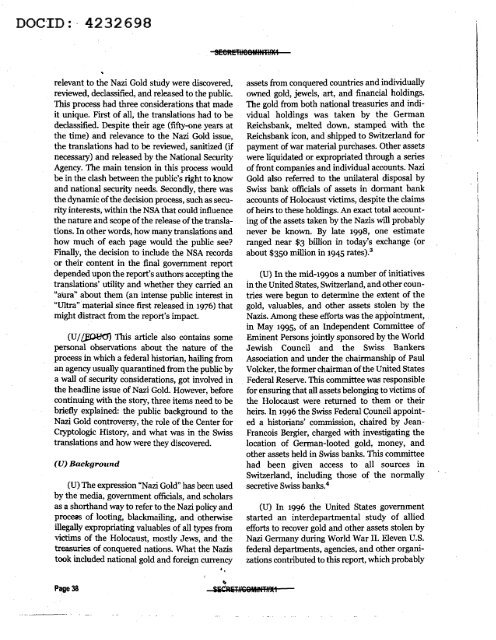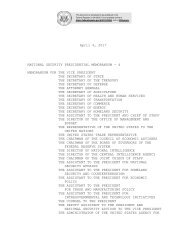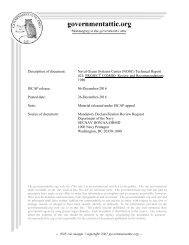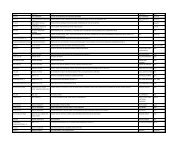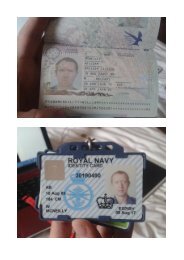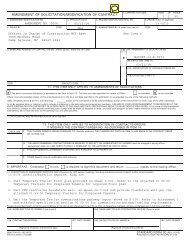government undersecretary
nsa-nazi-gold
nsa-nazi-gold
You also want an ePaper? Increase the reach of your titles
YUMPU automatically turns print PDFs into web optimized ePapers that Google loves.
DOC·ID: · 4232698<br />
relevant to the Nazi Gold study were discovered,<br />
reviewed, declassified, and released to the public.<br />
This process had three considerations that made<br />
it unique. First of all, the translations had to be<br />
declassified. Despite their age (fifty-one years at<br />
the time) and relevance to the Nazi Gold issue,<br />
the translations had to be reviewed; sanitized (if<br />
necessary) and released by the National Security<br />
Agency. The main tension in this process would<br />
be in the clash between the public's right to know<br />
and national security needs. Secondly, there was<br />
the dynamic of the decision process, such as security<br />
interests, within the NSA that could influence<br />
the nature and scope of the release of the translations.<br />
In other words, how many translations and<br />
how much of each page would the public see?<br />
Finally, the decision to include the NSA records<br />
or their content in the final <strong>government</strong> report<br />
depended upon the report's authors accepting the<br />
translations' utility and whether they carried an<br />
"aura" about them (an intense public interest in<br />
"Ultra" material since first released in 1976) that<br />
might distract from the report's impact.<br />
(U I~ This article also contains some<br />
personal observations about the nature of the<br />
process in which a federal historian, hailing from<br />
an agency usually quarantined from the public by<br />
a wall of security considerations, got involved in<br />
the headline issue of Nazi Gold. However, before<br />
continuing with the story, three items need to be<br />
briefly explained: the public background to the<br />
Nazi Gold controversy, the role of the Center for<br />
Cryptologic History, and what was in the Swiss<br />
translations and how were they discovered.<br />
(U) Background<br />
(U) The expression "Nazi Gold" has been used<br />
by the media, <strong>government</strong> officials, and scholars<br />
as a shorthand way to refer to the Nazi policy and<br />
proceiS of looting, blackmailing, and otherwise<br />
illegally expropriating valuables of all types from<br />
victims of the Holocaust, mostly Jews, and the<br />
treasuries of conquered nations. What the Nazis<br />
took included national gold and foreign currency<br />
assets from conquered countries and individually<br />
owned gold, jewels, art, and financial holdings.<br />
The gold from both national treasuries and individual<br />
holdings was taken by the German<br />
Reichsbank, melted down, stamped "With the<br />
Reichsbank icon, and shipped to Switzerland for<br />
payment of war material purchases. Other assets<br />
were liquidated or expropriated through a series<br />
of front companies and individual accounts. Nazi<br />
Gold also referred to the unilateral disposal by<br />
Swiss bank officials of assets in dormant bank<br />
accounts of Holocaust victims, despite the claims<br />
of heirs to these holdings. An exact total accounting<br />
of the assets taken by the Nazis will probably<br />
never be known. By late 1998, one estimate<br />
ranged near $3 billion in today's exchange (or<br />
about $350 million in 1945 rates). 3<br />
(U) In the mid-1990s a number of initiatives<br />
in the United States, Switzerland, and other countries<br />
were begun to determine the extent of· the<br />
gold, valuables, and other assets stolen by the<br />
Nazis. Among these efforts was the appointment,<br />
in May 1995, of an Independent Committee of<br />
Eminent Persons jointly sponsored by the World<br />
Jewish Council and the Swiss Bankers<br />
Association and under the chairmanship of Paul<br />
Volcker, the former chairman of the United States<br />
Federal Reserve. This committee was responsible<br />
for ensuring that all assets belonging to victims of<br />
the Holocaust were returned to them or their<br />
heirs. In 1996 the Swiss Federal Council appointed<br />
a historians' commission, chaired by Jean<br />
Francais. Bergier, charged with investigating the<br />
location of German-looted gold, money, and<br />
other assets held in Swiss banks. This committee<br />
had been given access to all sources in<br />
Switzerland, including those of the normally<br />
secretive Swiss banks. 4<br />
(U) In 1996 the United States <strong>government</strong><br />
started an interdepartmental study of allied<br />
efforts to recover gold and other assets stolen by<br />
Nazi Germany during World War II. Eleven U.S.<br />
federal departments, agencies, and other organizations<br />
contributed to this report, which probably<br />
Page38 Sit.Rii=F.'tG9MINT/Rt1 "


